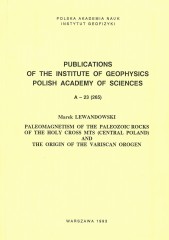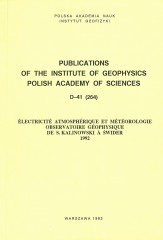BROWSE - VOLUME LIST
- A - Physics of the Earth's Interior
- B - Seismology
-
C - Geomagnetism
C-119, C-118, C-117, C-116, C-115, C-114, C-113, C-112, C-111, C-110, C-109, C-108, C-107, C-106, C-105, C-104, C-103, C-102, C-101, C-100, C-99, C-98, C-97, C-96, C-95, C-94, C-93, C-92, C-91, C-90, C-89, C-88, C-87, C-86, C-85, C-84, C-83, C-82, C-81, C-80, C-79, C-78, C-77, C-76, C-75, C-74, C-73, C-72, C-71, C-70, C-69, C-68, C-67, C-66, C-65, C-64, C-63, C-62, C-61, C-60, C-59, C-58, C-57, C-56, C-55, C-54, C-53, C-52, C-51, C-50, C-49, C-48, C-47, C-46, C-45, C-44, C-43, C-42, C-41, C-40, C-39, C-38, C-37, C-36, C-35, C-33, C-32, C-31, C-30, C-29, C-28, C-27, C-26, C-25, C-24, C-23, C-22, C-21, C-20, C-19, C-18, C-17, C-16, C-15, C-14, C-13, C-12, C-11, C-10, C-9, C-8, C-7, C-6, C-5, C-4, C-3, C-2, C-1
-
D - Physics of the Atmosphere
D-79, D-78, D-77, D-76, D-75, D-74, D-73, D-72, D-71, D-70, D-69, D-68, D-67, D-66, D-65, D-64, D-63, D-62, D-61, D-60, D-59, D-58, D-57, D-56, D-55, D-54, D-53, D-52, D-51, D-50, D-49, D-48, D-47, D-46, D-44, D-45, D-43, D-42, D-41, D-40, D-39, D-38, D-37, D-35, D-34, D-33, D-32, D-31, D-30, D-28, D-27, D-26, D-25, D-24, D-23, D-22, D-21, D-20, D-19, D-18, D-17, D-16, D-15, D-14, D-13, D-12, D-11, D-10, D-9, D-8, D-7, D-6, D-5, D-4, D-3, D-2, D-1
- E - Hydrology
- P - Polar Research
- M - Miscellanea
-
Online First
Browse - Volume list
Paleomagnetism of the Paleozoic Rocks of the Holy Cross Mts (Central Poland) and the Origin of the Variscan Orogen
Author(s): Lewandowski M.
Volume: 265
Series: A-23
Volume: 265
Series: A-23
The Holy Cross Mts are an old, Paleozoic massif, situated close to the Tornquist-Teisseyre Tectonic Zone and structurally incorporated into the Epi-Variscan platform. The area consists of two main units, namely the northern (NHCM) and the southern (SHCM), separated by the west-northwesterly striking Holy Cross Dislocation. Both regions differ significantly in the history of facial development, continuity of the stratigraphical record, the thickness of rock successions and the history of geotectonic development. An interesting question was whether these differences were also reflected in the paleomagnetic record.
Électricité Atmosphérique et Météorologie Observatoire Géophysique de S. Kalinowski à Świder 1992
Author(s): Warzecha S., Kubicki M.
Volume: 264
Series: D-41
Volume: 264
Series: D-41
The present issue contains the results of recordings of some elements of atmospheric electricity and daily observations of major meteorological factors noted at the S. Kalinowski Geophysical Observatory of the Polish Academy of Sciences at Świder in 1992.
Atmospheric Ozone, Solar Radiation, 1992
Author(s):
Volume: 263
Series: D-40
Volume: 263
Series: D-40
Ozone observations have been made by means of Dobson spectrophotometer No. 84 in the Geophysical Observatory at Belsk since March 1963. This publication presents all total ozone values and vertical distribution of ozone over Belsk in 1992 obtained from the conventional Umkehr observations.
A Kinetic Model of the Evolution of Cracks
Author(s): Czechowski Z.
Volume: 262
Series: A-22
Volume: 262
Series: A-22
The paper presents a kinetic approach to the problem of evolution of numerous cracks. The ensemble of microcracks is described by the size distribution function of cracks. Using the methods of the kinetic theory of gases, we derive the nonlinear, integro-differential equation of evolution of the size distribution function. We assume that cracks can nucleate with some nucleation rate, propagate with probability P and velocity v, and that they can coalesce with other cracks. The probability of crack fusion is defined by fusion cross-section.
Fault Zone Dynamics Evolution Patterns
Author(s): Senatorski P.
Volume: 261
Series: A-21
Volume: 261
Series: A-21
A model of fault zone dynamics is proposed. Slips along complex fault system, long-range interactions, any distribution of barriers and asperities (modelled by cohesive forces with breakdown strengths and non-zero breakdown slips), a velocity-dependent friction, healing and reactivation of cohesive forces, a circular causality between earthquakes and tectonic stresses are taken into account.






